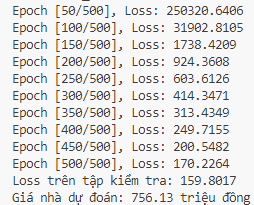Xây Dựng Mạng Nơ-ron Kết Nối Đầy Đủ (Fully Connected Neural Network - FCNN) Để Dự Đoán Giá Nhà
Chúng ta sẽ xây dựng một mạng nơ-ron kết nối đầy đủ (FCNN) để dự đoán giá nhà dựa trên các thông tin đầu vào như: diện tích nhà (m²), số phòng ngủ, số phòng tắm, vị trí. Sử dụng mạng nơ-ron nhân tạo (Artificial Neural Network - ANN) với các lớp kết nối đầy đủ (Fully Connected Layers).
Bước 1: cài đặt các thư viện cần thiết
import torch
import torch.nn as nn
import torch.optim as optim
import numpy as np
import pandas as pd
from sklearn.model_selection import train_test_split
from sklearn.preprocessing import StandardScaler
Bước 2: chuẩn bị dữ liệu
# bước 2 chuẩn bị dữ liệu
# Tạo dữ liệu nhà đất (giả lập)
data = {
'Diện tích (m2)': [50, 60, 70, 80, 90, 100, 110, 120, 130, 140],
'Số phòng ngủ': [1, 2, 2, 3, 3, 3, 4, 4, 4, 5],
'Số phòng tắm': [1, 1, 2, 2, 2, 3, 3, 3, 4, 4],
'Vị trí': [1, 2, 2, 3, 3, 3, 4, 4, 4, 5], # Mã hóa vị trí thành số
'Giá nhà (triệu đồng)': [500, 600, 650, 700, 750, 800, 850, 900, 950, 1000]
}
df = pd.DataFrame(data)
# Chia dữ liệu thành đầu vào (X) và đầu ra (y)
X = df.drop(columns=['Giá nhà (triệu đồng)']).values
y = df['Giá nhà (triệu đồng)'].values.reshape(-1, 1)
# Chia tập dữ liệu thành tập huấn luyện (80%) và tập kiểm tra (20%)
X_train, X_test, y_train, y_test = train_test_split(X, y, test_size=0.2, random_state=42)
# Chuẩn hóa dữ liệu đầu vào để tăng hiệu suất mô hình
scaler = StandardScaler()
X_train_scaled = scaler.fit_transform(X_train)
X_test_scaled = scaler.transform(X_test)
# Chuyển dữ liệu thành tensor PyTorch
X_train_tensor = torch.tensor(X_train_scaled, dtype=torch.float32)
y_train_tensor = torch.tensor(y_train, dtype=torch.float32)
X_test_tensor = torch.tensor(X_test_scaled, dtype=torch.float32)
y_test_tensor = torch.tensor(y_test, dtype=torch.float32)
Bước 3: Xây Dựng Mô Hình FCNN với PyTorch
# Bước 3: Xây Dựng Mô Hình FCNN với PyTorch
# Định nghĩa mô hình mạng nơ-ron kết nối đầy đủ
class FCNN(nn.Module):
def __init__(self):
super(FCNN, self).__init__()
self.fc1 = nn.Linear(X_train.shape[1], 32) # Lớp ẩn 1
self.fc2 = nn.Linear(32, 16) # Lớp ẩn 2
self.fc3 = nn.Linear(16, 8) # Lớp ẩn 3
self.fc4 = nn.Linear(8, 1) # Lớp đầu ra
def forward(self, x):
x = torch.relu(self.fc1(x))
x = torch.relu(self.fc2(x))
x = torch.relu(self.fc3(x))
x = self.fc4(x) # Hồi quy dùng hàm kích hoạt tuyến tính
return x
# Khởi tạo mô hình
model = FCNN()
# Hàm mất mát và bộ tối ưu hóa
criterion = nn.MSELoss()
optimizer = optim.Adam(model.parameters(), lr=0.01)
Bước 4: Huấn luyện mô hình
# Bước 4 huấn luyện
# Số epoch
num_epochs = 500
for epoch in range(num_epochs):
model.train()
# Forward pass
y_pred = model(X_train_tensor)
loss = criterion(y_pred, y_train_tensor)
# Backward pass
optimizer.zero_grad()
loss.backward()
optimizer.step()
# Hiển thị loss mỗi 50 epoch
if (epoch+1) % 50 == 0:
print(f"Epoch [{epoch+1}/{num_epochs}], Loss: {loss.item():.4f}")
Bước 5: Đánh giá mô hình
# Bước 5: đánh giá
# Đánh giá mô hình trên tập kiểm tra
model.eval()
with torch.no_grad():
y_pred_test = model(X_test_tensor)
test_loss = criterion(y_pred_test, y_test_tensor)
print(f"Loss trên tập kiểm tra: {test_loss.item():.4f}")
Bước 6: Dự đoán giá mới
# bước 6:dự đoán
# Dữ liệu nhà mới cần dự đoán
new_house = np.array([[100, 3, 2, 3]]) # Diện tích 100m2, 3 phòng ngủ, 2 phòng tắm, vị trí 3
new_house_scaled = scaler.transform(new_house) # Chuẩn hóa dữ liệu mới
new_house_tensor = torch.tensor(new_house_scaled, dtype=torch.float32)
# Dự đoán giá nhà
with torch.no_grad():
predicted_price = model(new_house_tensor).item()
print(f"Giá nhà dự đoán: {predicted_price:.2f} triệu đồng")
Kết quả của mô hình là:

Ảnh 4‑11: kết quả của mô hình FCNN dự đoán giá nhà
Nếu ta sử dụng phương pháp hồi quy tuyến tính:
import numpy as np
import pandas as pd
from sklearn.model_selection import train_test_split
from sklearn.preprocessing import StandardScaler
from sklearn.linear_model import LinearRegression
from sklearn.metrics import mean_squared_error
# Tạo dữ liệu giả lập (giống như bài toán FCNN)
data = {
'Diện tích (m2)': [50, 60, 70, 80, 90, 100, 110, 120, 130, 140],
'Số phòng ngủ': [1, 2, 2, 3, 3, 3, 4, 4, 4, 5],
'Số phòng tắm': [1, 1, 2, 2, 2, 3, 3, 3, 4, 4],
'Vị trí': [1, 2, 2, 3, 3, 3, 4, 4, 4, 5], # Mã hóa vị trí thành số
'Giá nhà (triệu đồng)': [500, 600, 650, 700, 750, 800, 850, 900, 950, 1000]
}
df = pd.DataFrame(data)
# Tách đầu vào (X) và đầu ra (y)
X = df.drop(columns=['Giá nhà (triệu đồng)']).values
y = df['Giá nhà (triệu đồng)'].values
# Chia dữ liệu thành tập huấn luyện và tập kiểm tra (80% train, 20% test)
X_train, X_test, y_train, y_test = train_test_split(X, y, test_size=0.2, random_state=42)
# Chuẩn hóa dữ liệu
scaler = StandardScaler()
X_train_scaled = scaler.fit_transform(X_train)
X_test_scaled = scaler.transform(X_test)
# Khởi tạo mô hình hồi quy tuyến tính
model = LinearRegression()
# Huấn luyện mô hình
model.fit(X_train_scaled, y_train)
# Dự đoán trên tập kiểm tra
y_pred = model.predict(X_test_scaled)
# Tính toán MSE và RMSE
mse = mean_squared_error(y_test, y_pred)
rmse = np.sqrt(mse)
print(f"MSE: {mse:.4f}")
print(f"RMSE: {rmse:.4f}")
# Hệ số hồi quy và bias
print("Hệ số hồi quy:", model.coef_)
print("Bias:", model.intercept_)
# Dự đoán giá nhà mới (diện tích 100m2, 3 phòng ngủ, 2 phòng tắm, vị trí 3)
new_house = np.array([[100, 3, 2, 3]])
new_house_scaled = scaler.transform(new_house)
predicted_price = model.predict(new_house_scaled)
print(f"Giá nhà dự đoán: {predicted_price[0]:.2f} triệu đồng")
Ta có kết quả như sau:

Ảnh 4‑12: Kết quả dự đoán giá nhà dựa trên phương pháp hồi quy tuyến tính
Từ 2 kết quả trên ta thấy cũng có sự tương đồng giữa giá dự đoán. Tuy nhiên hồi quy tuyến tính có thể áp dụng để dự đoán giá nhà nếu mối quan hệ tuyến tính chi phối dữ liệu. Nếu dữ liệu có sự phi tuyến tính mạnh, mạng neural sẽ có độ chính xác cao hơn. Hồi quy tuyến tính chạy nhanh hơn và dễ triển khai, nhưng FCNN có khả năng học tốt hơn trên tập dữ liệu lớn và phức tạp.













Bình luận